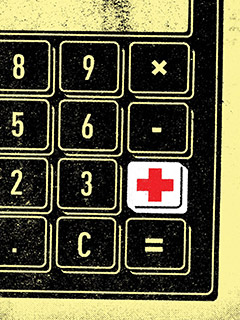Features
Messages
Digest
Short Stories
Do the Math
Hospitalize or not? Researchers develop model to help ER docs decide if patients with heart failure are at risk of death in the near term
By Alisa Kim
 It's a common scenario in the emergency room: a person anxiously seeks care because of chest pain and difficulty breathing. Upon examination, the physician notes the patient's legs are very swollen. A chest X-ray, blood work and an electrocardiogram, a test that records the heart's electrical activity, point to the cause: heart failure.
It's a common scenario in the emergency room: a person anxiously seeks care because of chest pain and difficulty breathing. Upon examination, the physician notes the patient's legs are very swollen. A chest X-ray, blood work and an electrocardiogram, a test that records the heart's electrical activity, point to the cause: heart failure.
In North America, there are one million visits to the emergency department (ED) for heart failure each year. In Canada, heart failure claims more than 4,200 lives annually. While the condition can be tricky to identify—physicians must first rule out other causes of the patient's symptoms—harder still is determining the risk of death in the short term. If the risk is high, then immediate hospitalization is required; if the risk is low, then the patient can be discharged, with close monitoring.
"I think everyone who treats heart failure patients in the emergency room thinks, 'Can I safely send this patient home, or do they need to be admitted?' These days if you can avoid hospitalizing someone, you want to do that—it's better for the patient and for the system," says Dr. Jack Tu, a senior scientist in the Schulich Heart Research Program at Sunnybrook Research Institute (SRI).
These days if you can avoid hospitalizing someone, you want to do that.
Heart failure does not mean the heart has stopped working; in essence, it's a pumping problem: the damaged muscle cannot pump enough blood throughout the body to meet its needs. The condition is sometimes confused with a heart attack, in which an area of heart tissue dies when the flow of oxygen-rich blood is cut off. Heart disease, also called coronary artery disease, refers to the narrowing of the blood vessels to the heart, and contributes to heart failure and heart attacks.
In 2012, Tu and colleagues published a study in the Annals of Internal Medicine containing the first model to predict the probability of death in the short term among heart failure patients in the ED. The study is a rare collaboration between clinicians and researchers in cardiac and emergency medicine. It took place at Sunnybrook Health Sciences Centre and the Institute for Clinical Evaluative Sciences.
The Emergency Heart Failure Mortality Risk Grade is an algorithm that calculates the risk of death within seven days among heart failure patients coming to the ED. The model uses routinely collected information like age, initial vital signs, clinical features and results from blood work to calculate the risk score; the higher the score, the greater the risk.
The tool is unique in that it can help ED physicians, including cardiologists, internists and emergency room doctors, formulate a patient's prognosis (the course or outcome of a disease) based on measurable data, versus clinical judgment alone.

Drs. Michael Schull (left) and Jack Tu in the emergency room (ER) at Sunnybrook are coauthors of a study examining risk of death among heart failure patients in the ER.
Photo: Doug Nicholson
"Heart failure is one of those conditions where we know some patients probably need to be admitted and some are safe to send home. But we don't know how to distinguish between those groups. I think [the tool] is helpful in saying, 'This patient is low-risk; I'm more comfortable sending them home. Or, this patient is high-risk, and we probably should bring them in," says Dr. Michael Schull, a senior scientist at SRI, emergency physician at Sunnybrook and a co-author of the study.
![]()
Calculate This
The Emergency Heart Failure Mortality Risk Grade is a tool to help doctors in their decision-making by providing an estimate of risk of death within seven days in patients presenting to the emergency department. Following are the variables used to calculate the risk score:
Age
Arrival by ambulance
Triage systolic blood pressure (a low number in a heart failure patient could indicate dysfunction of the left ventricle of the heart)
Triage heart rate (in heart failure, the heart beats faster to compensate for weaker pumping power to maintain blood flow around the body)
Triage oxygen saturation (lower saturation reflects breathing problems and build-up of fluid in the lungs)
Potassium concentration (an abnormal blood level can cause irregular heart rhythms; very high or low values can cause the heart to stop beating)
Creatinine concentration (elevated blood levels indicate abnormal kidney function, which is associated with an increased risk of death)
Troponin level (measures proteins released in the blood when the heart muscle is damaged)
Any active cancer
Use of metolazone at home (a diuretic, or water pill, used to lower blood pressure and prevent excess fluid accumulation in heart failure)
The risk score is online at www.ccort.ca
To develop the model, researchers used data from more than 12,500 patients who visited an ED in an Ontario hospital due to heart failure between 2004 and 2007. Patients were divided into two groups: one to come up with the model, the other to validate it. In each of the groups, two-thirds of the patients were hospitalized and one-third were discharged.
The researchers used data from the patients' charts to select the risk variables. The end point was death within seven days of initial presentation to the ED. Of the 30-plus variables they considered, the team narrowed down the model's risk factors to 10, some of which include age, arrival by ambulance, heart rate, oxygen saturation and the presence of cancer (see sidebar for full list).
The model accurately predicted the deaths within seven days of both hospitalized and discharged patients.
What sets this study apart from other prognostic models for heart failure patients is that it included patients discharged from the ED, who were also at risk of short-term death. The risk score thus may be useful to ED physicians because it can be applied to assist with the decision to admit or discharge.
"Prior to this, doctors didn't really have any tools to help them decide which patients needed to be admitted and which patients could be sent home from the ED. We thought this tool would be very useful to help doctors make those decisions," says Tu, who is also a cardiologist at Sunnybrook and a professor of medicine at the University of Toronto.
One of the challenges for ED physicians making this decision is the lack of criteria by which admission can be guided. The decision is left to their discretion as they consider the severity of the patient's symptoms, whether the patient has other illnesses, his or her response to initial treatment, and if the patient has social support.
"There's no standard way of approaching all those different factors, and different physicians do it differently. This is one area where there's a need for standardization in order to try and improve care," says Schull, who is also a professor at U of T.
Moreover, the wrong choice has serious consequences. "Emergency department physicians sometimes do not realize how sick [heart failure] patients are, and are sending them home. On the other [end of the] spectrum, we've found that some patients who are hospitalized are very low-risk and perhaps may not have even needed an admission to hospital. There are clearly some safety issues with some patients dying at home, and some low-risk patients being admitted to hospital who may not need it," says Dr. Douglas Lee, lead author of the study and a cardiologist at Toronto General Hospital.
The tool could also result in big savings in health care spending. The average length of stay for routine hospitalization due to heart failure is eight days, at a cost of about $10,000, notes Lee. "Hospitalizations are probably the most expensive part of heart failure care. If we can avert hospitalizations in low-risk patients, that would be millions of dollars saved to the health care system," Lee says.

Dr. Douglas Lee, a scientist at the Institute for Clinical Evaluative Sciences, and lead author of the study.
Photo: Jacqueline Forrester
While the researchers say the tool is useful, they note it should not replace a clinician's judgment. "It's important to remember that it's still the physician's decision whether to admit the patient or not. [The risk score] doesn't capture every single factor in the decision to hospitalize someone or not. For example, if you have an elderly patient who doesn't have any family members to look after them, then even if they have a very low risk score you may want to hospitalize them for social reasons," says Tu.
The risk score calculator is available online and has had over 10,000 hits. The researchers are developing smart phone applications so that ED physicians can have the tool at their fingertips. Their plan is to have the "apps" available for users to download later this year.
A related research direction involves establishing concrete values for high- and low-risk heart failure patients. "Figuring out the risk of death is a great place to start," says Schull. "Exactly where the cut-off should be is where we need to do some more work. It would be nice to say these criteria mean admission versus discharge, as opposed to a range of risk."
The tool could also have an impact on health care systems outside Canada. Lee and Tu are working with American emergency physicians who have expressed interest in doing a study to see if the risk calculator works using U.S. patient data. The resource implications are even greater there, where, due to concerns over malpractice suits, an overwhelming majority of heart failure patients are hospitalized.
Lee says that although the tool is relatively simple, it could make a big difference, which speaks to why he got his PhD. "At the outset of my career, I had to make a decision: do I want to be a clinician-scientist or a clinician? I thought I could have more impact by doing research. Seeing patients and treating them is very important, but you treat one patient at a time. If you're doing research, you're helping thousands, maybe hundreds of thousands of people."
This research was funded by the Canadian Institutes of Health Research and the Heart and Stroke Foundation of Ontario. Tu also received support from the Canada Research Chairs program, through which he holds the Canada Research Chair in Health Services Research.


- << Features |
- Previous: On Target? •
- Next: Why Pay Less?
- |Messages >>



